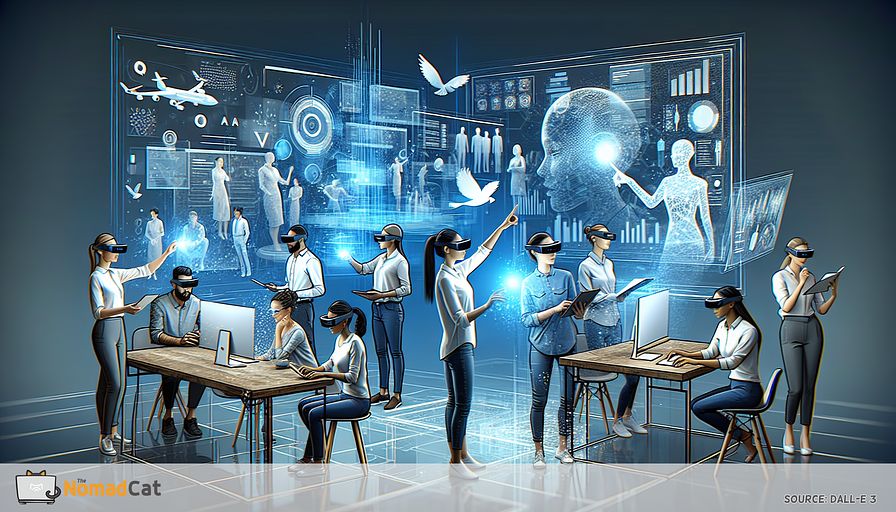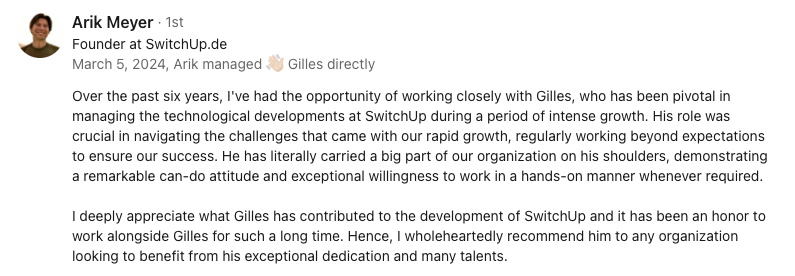Abstract:
Augmented Reality (AR) is revolutionizing the workplace by introducing innovative productivity and collaboration tools that are reshaping how businesses operate. From enhancing training and development to facilitating remote assistance, AR applications are making it easier for teams to interact with digital information in a physical context. This technology not only broadens the scope of remote work possibilities but also improves operational efficiency across industries. As AR becomes more accessible, companies are exploring its potential to streamline processes, enhance employee engagement, and foster a more interactive and engaging work environment. This article explores the various ways AR is being integrated into workplace practices, highlighting the benefits and challenges it brings along. It is clear that AR technology holds significant promise for enhancing business operations, making it a crucial tool for future-oriented businesses looking to stay ahead in the competitive landscape.
Augmenting Reality in the WorkplaceAn Unexpected Transformation: AR's Dramatic Entrance into Work Settings
Imagine walking into a traditional office, only to find employees fixing a complex piece of machinery using nothing but their glasses—spectacles, not the crystal ware! This isn't a scene from a sci-fi movie; it’s reality for some notable companies leveraging Augmented Reality (AR) in fascinating ways. Once upon a time, AR was a buzzword associated primarily with gaming and entertainment. Fast forward to today, and it's transforming work settings in ways we could only dream of. By overlaying digital information onto the physical world, AR has turned the workplace into a dynamic environment where the lines between the digital and the physical are blurred, enhancing not just workplace productivity but also pioneering new forms of collaboration tools.
The marriage of AR with the workplace isn't just about showing off nifty gadgets; it's fundamentally changing how tasks are performed, making complicated processes simpler and mundane tasks more engaging. It’s like having a superpower, except it’s real, and it's available today. From virtual manuals that float beside machinery, guiding technicians through repairs, to immersive virtual meetings that feel as personal as sitting across the table from your colleague, AR is not just an add-on. It’s becoming a core component of how businesses operate, promising significant boosts in efficiency and creativity across the board.
As we prepare to delve deeper, let’s appreciate the scope of change AR brings to the workplace. Beyond the sheer novelty, it represents a significant leap forward in how we think about work, space, and connectivity, marking the beginning of a journey into a futuristic way of working that was once only imaginable.
Enhancing Training and Development with AR
Think back to the last time you sat through a traditional training session. Chances are, you were fighting the urge to yawn or daydream about what's for dinner. Enter Augmented Reality (AR), the superhero swooping in to save the day (or at least, the training session). AR in training and development isn't just a fancy gimmick; it's revolutionizing how skills are acquired and making the learning process infinitely more interactive and, dare we say, fun. By injecting digital content into the real world, AR turns an ordinary room into an interactive learning playground, engaging employees in a way that manuals and PowerPoint slides could only dream of.
Turning Training on Its Head with Interactive Learning
Gone are the days when learning about machinery meant poring over hefty manuals or watching outdated videos. Today, AR can project virtual models of machinery right before your eyes, allowing you to learn about each component with the mere tap of a digital button. Picture yourself assembling a virtual engine or navigating through complex machinery parts without touching a single tool. It's not just hands-on learning; it's minds-on, enhancing understanding and retention in ways traditional methods can't match.
Beyond mechanical wizardry, AR is transforming customer service training with role-playing scenarios that are as close to real life as it gets without the uncomfortable eye contact. Trainees can interact with virtual customers, navigate through challenging service requests, and receive instant feedback, all within a controlled environment. It's like practicing on a flight simulator before flying a plane—a safe space to make mistakes and learn without the pressure of real-life consequences.
Examples of AR Magic in Action
Let's sprinkle some examples of this AR sorcery in the workplace:
- Virtual Assembly: Employees wearing AR glasses can see a digital overlay of assembly instructions directly on their workspace, guiding them step-by-step in assembling hardware. This not just accelerates the learning curve but also reduces errors in a real production environment.
- Role-Playing Scenarios: Customer service representatives can engage in AR-based simulations, interacting with 3D avatars of customers in a variety of scenarios. This immersive training enhances empathy, problem-solving skills, and customer interaction tactics.
These are not scenes from a futuristic novel; they're happening in companies around the globe, turning training sessions into dynamic and interactive learning experiences.
The Sea Change in Employee Development
The shift from traditional training methods to AR-assisted learning signifies a sea change in employee development. By making learning processes more engaging, effective, and scalable, AR doesn’t just enhance skill acquisition; it reimagines it. Employees can now learn at their pace, revisit complex procedures as needed, and get hands-on experience without the associated risks or resources typically required. This doesn't just benefit the employees but also the organizations, which see faster onboarding, higher competency levels, and greater flexibility in training programs.
Waving goodbye to yawn-inducing manuals and hello to interactive, engaging learning experiences, AR in training and development is not just a fleeting trend. It's a foundational shift in how we approach skill-building, promising a brighter, more engaging future for workplace learning. As we continue to explore the impact of AR in the workplace, it's clear that its potential to enrich and enhance training and development is just beginning to be tapped. Stay tuned, the best is yet to come.
Facilitating Remote Work and Operational Efficiency
As the boundaries between physical and digital realms increasingly blur, Augmented Reality (AR) emerges as a powerful conduit, enhancing not just remote work but redefining operational efficiency. Imagine, if you will, experts guiding onsite technicians through complex repairs from thousands of miles away, or architects walking through a building that exists only as digital information overlaid on a barren plot. These aren't plots from a speculative fiction novel but real-world scenarios made possible through AR.
The Virtual Bridge for Remote Assistance
In a world where remote work has transitioned from a luxury to a necessity for many, AR stands as a lighthouse, guiding the way toward a seamless integration of expertise across distances. Through AR glasses or applications, experts can superimpose digital imagery and instructions onto the physical workspace of a remote colleague, providing real-time assistance without being physically present. This "see what I see" technology not only breaks down geographical barriers but also ensures that expert knowledge is just a whim away.
The implications are vast—ranging from machinery repair and installation to complex medical procedures. Engineers can guide technicians through intricate equipment installations, helping to spot and solve problems in real-time. Medical professionals can overlay digital markers on a patient undergoing surgery miles away, offering invaluable guidance to operating surgeons. Thus, AR plays matchmaker between digital expertise and physical execution.
Boosting Operational Efficiency Across the Board
But the magic of AR isn’t confined to remote work alone. It stretches its digital tendrils into the very heart of operational efficiency. By overlaying crucial digital information within the physical work environment, AR enables workers to make informed decisions swiftly, reduce errors, and complete tasks with an efficiency that would make even the most seasoned productivity guru turn green with envy.
Consider the case of logistics and warehousing, where AR can transform mundane inventory management into a high-tech treasure hunt. Workers equipped with AR devices can receive visual guidance directly in their field of view, leading them to the exact location of items in a sprawling warehouse. This not only speeds up the process but reduces the scope for human error, streamlining operations, and improving overall efficiency.
In the manufacturing sector, AR assists in identifying potential issues before they become costly downtimes. For example, workers can use AR to visualize the internal components of machinery, predict maintenance needs, and troubleshoot problems without dismantling the equipment. This predictive approach to maintenance ensures machinery runs smoothly, reducing interruptions and maintaining a steady flow of productivity.
- Remote Expert Assistance: Leveraging AR for guiding through repairs or tasks remotely, ensuring high standards without geographical constraints.
- Inventory Management: Transforming the way workers interact with space and inventory, making for an efficient and error-free process.
- Preventive Maintenance: Visualizing and predicting maintenance needs before issues escalate, bolstering the continuous operational flow.
In essence, AR doesn’t just facilitate remote work; it reimagines it, transforming physical tasks into a synergy of digital precision and human skill. Meanwhile, its impact on operational efficiency paints a future where mistakes are a rarity, and productivity is the status quo. As industries catch up to the potential of AR, the workplace continues to evolve, promising a future where augmented reality is just reality.
Challenges and Future Outlook
Navigating the Rough Waters: Challenges in AR Integration
Despite Augmented Reality's potential to transform workplaces into something akin to a page out of a science-fiction novel, integrating AR into everyday business operations isn't without its hurdles. Like every great innovation, AR in the workplace faces its fair share of challenges that sometimes feel like trying to solve a Rubik’s Cube in the dark. These range from technological adoption barriers, concerns over privacy, to the bespoke nature of solutions required to fit diverse business needs.
Technological adoption, for instance, is not just about having the latest gadgets but ensuring compatibility with existing systems and workflows. It's akin to trying to fit a square peg in a round hole, requiring significant time and resources to reshape the business environment to seamlessly integrate with AR technologies. Moreover, the sticker shock of initial setup costs can cause even the most enthusiastic tech aficionados to pause and reconsider.
As if convincing the budget committee wasn't tricky enough, there's the omnipresent specter of privacy concerns. Implementing AR solutions that overlay digital information onto the real world raises eyebrows about the security of sensitive data. This is not just about ensuring that the virtual coffee cup doesn’t accidentally spill over into confidential documents but involves implementing robust data encryption and access controls to protect against cyber threats.
Furthermore, the customization conundrum cannot be ignored. Unlike off-the-shelf software that promises a one-size-fits-all solution, effective AR implementations often require tailoring to the unique requirements of each business, from custom content creation to integration with specialized equipment. This demands a level of investment and expertise that can be daunting, turning the dream of an AR-enhanced workplace into a formidable project.
Embracing the Horizon: A Step Towards the Future
However, like every cloud's silver lining, these challenges in integrating AR into the workplace are not insurmountable obstacles but rather stepping stones towards innovation and progress. Forward-thinking businesses recognize that navigating through these waters is part of the journey towards a future where work is more engaging, efficient, and exciting. Overcoming the hurdles of technological adoption, privacy, and customization is akin to unlocking new levels in a highly immersive game, revealing opportunities for enhanced employee engagement and sustained competitive advantage.
The key lies in adopting a strategic approach towards AR integration, one that involves thoughtful planning, gradual implementation, and continuous learning. It also includes fostering partnerships with AR technology providers who understand the unique needs of your business and can guide you through the maze of options available. Just as importantly, a culture that prioritizes innovation and is open to exploring new technologies can smooth the path forward.
In the grand scheme of things, AR offers a kaleidoscope of possibilities to enhance how work is done, from making complex processes simpler to transforming mundane tasks into interactive experiences. By focusing on the value AR brings to employee training, remote work, and operational efficiency, businesses can not only navigate the present challenges but also pave the way for a future where AR is an integral part of the workplace tapestry.
The Crystal Ball Gazing: What Does the Future Hold?
As we stand on the cusp of what could very well be a revolution in workplace dynamics, it's tempting to gaze into a crystal ball and speculate about the future of AR in the workplace. Will AR glasses become as common as the smartphone? Will virtual meetings make business travel as outdated as sending faxes? While only time will unveil the full scope of AR's impact, one thing is certain: the role of AR in shaping the future of work is poised for explosive growth.
Businesses that are quick to recognize and adapt to the transformative potential of AR will not only lead the pack in innovation but also set new standards for employee engagement, operational efficiency, and competitive edge. As AR continues to mature and become more accessible, its integration into workplace practices is expected to accelerate, offering a glimpse into a future where augmented reality and reality are one and the same.
In a world where work and play increasingly intertwine, AR stands as a beacon of futuristic workmanship, challenging us to reimagine the boundaries of what's possible. As we peer into the horizon, one question lingers: Are we ready to embrace the augmented reality of our workplace futures, or will we cling to the nostalgia of the familiar? Either way, the journey promises to be an exciting one, ripe with opportunities for those daring enough to take the leap.
You might be interested by these articles:
- Holographic Collaboration Tools
- Transforming Work with AR Technology
- Augmented reality's green revolution in sustainable innovation





